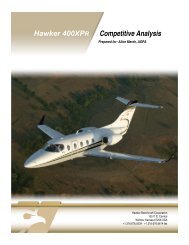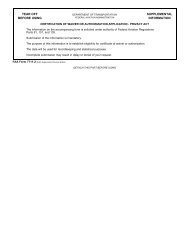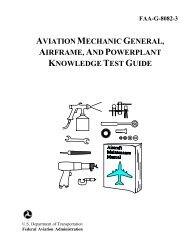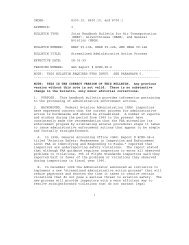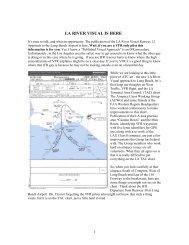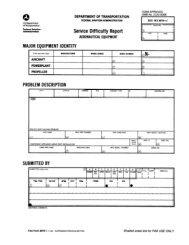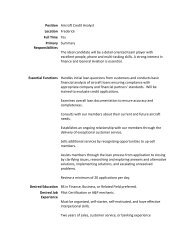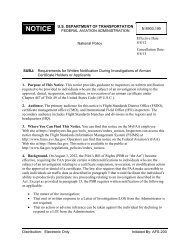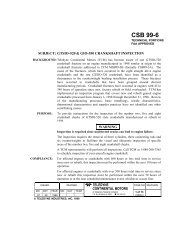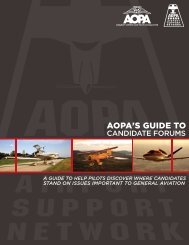2008 Nall Report - Aircraft Owners and Pilots Association
2008 Nall Report - Aircraft Owners and Pilots Association
2008 Nall Report - Aircraft Owners and Pilots Association
Create successful ePaper yourself
Turn your PDF publications into a flip-book with our unique Google optimized e-Paper software.
6 (27.3%)<br />
<strong>2008</strong> NALL REPORT<br />
Collisions<br />
15 (68.2%)<br />
25 (41.0%)<br />
Loss of power<br />
Accident Factors: High-Risk Fatal Phases of Flight<br />
Gusts/wake<br />
turbulence<br />
1 (4.5%)<br />
3 (4.9%)<br />
9 (14.8%)<br />
Total<br />
0 5 10 15 20 25<br />
Stall/loss<br />
of control<br />
Hit wires or<br />
structures<br />
Mountains<br />
or canyons<br />
Aerobatics<br />
Stalled or<br />
settled on<br />
takeoff<br />
Stalled during<br />
climb<br />
Loss of control<br />
Weight/density<br />
altitude<br />
Runway<br />
conditions<br />
Other<br />
Each flight progresses through a series of phases,<br />
some of which present more risk than others. Underst<strong>and</strong>ably,<br />
the parts of each flight that are close<br />
to the ground have higher risk. This section analyzes<br />
accidents that occurred during those phases<br />
of flight.<br />
Takeoff <strong>and</strong> Climb<br />
162 total/30 fatal<br />
Typical takeoff <strong>and</strong> climb accidents occur for one<br />
or more of the following reasons:<br />
15 (16.5%)<br />
14 (27.5%)<br />
Total<br />
• Takeoff Stall/Settling – These involve loss of<br />
Fatal<br />
airspeed, with the airplane either entering a stall<br />
or developing 11 (12.1%) a sink rate from which the pilot does<br />
not recover in time.<br />
11 (21.6%)<br />
• Loss of Control – Crosswinds <strong>and</strong> other conditions<br />
can lead to an inability of the pilot to main-<br />
6 (6.6%)<br />
tain directional 4 (7.8%) control. In such cases, the airplane<br />
can depart the runway <strong>and</strong> collide with runway<br />
lights, vehicles, <strong>and</strong> other surface obstructions.<br />
0 10 20 30 40 50 60<br />
• Weight/Density Altitude – The combination<br />
of high temperatures <strong>and</strong> high altitude results in<br />
22 (13.6%)<br />
22 (43.1%)<br />
59 (64.8%)<br />
Types of Takeoff <strong>and</strong> Climb Accidents<br />
5 (16.7%)<br />
2 (6.7%)<br />
1 (3.3%)<br />
11 (6.8%)<br />
8 (26.7%)<br />
9 (30.0%)<br />
5 (16.7%)<br />
19 (11.7%)<br />
17 (10.5%)<br />
24 (14.8%)<br />
69 (42.6%)<br />
Total<br />
Fatal<br />
0 10 20 30 40 50 60 70 80<br />
Figure 26<br />
significantly reduced airplane performance. Such<br />
conditions can prevent the airplane from being<br />
able to climb sufficiently to clear obstructions.<br />
• Runway Conditions – The type of runway surface<br />
(paved, grass, gravel, etc.) <strong>and</strong> any contamination<br />
such as water or ice can be a factor in takeoff<br />
accidents.<br />
During <strong>and</strong> immediately following takeoff, the<br />
aircraft is operating close to the ground <strong>and</strong> at<br />
low speeds. As shown in Figure 26, accidents<br />
during takeoff were primarily due to losses of<br />
aircraft control (69 of 151 takeoff accidents, or<br />
45.7 percent). More than one-third of those (24)<br />
were ascribed to gusts or crosswinds, with inadequate<br />
airspeed control causing stalls or settling<br />
(22, 14.6 percent of takeoff accidents), high density<br />
altitude or over-gross takeoff attempts (19,<br />
12.6 percent), <strong>and</strong> unsuitable runway conditions<br />
(17, 11.3 percent) accounting for the remainder.<br />
Such accidents included collisions with objects<br />
or vehicles during the takeoff roll, inappropriate<br />
aircraft configuration, attempts to take off with<br />
known aircraft deficiencies, <strong>and</strong> fuel contamination.<br />
Eight of the 11 accidents (72.7 percent ) that occurred<br />
during climb above the traffic pattern were<br />
fatal, compared to only 14.6 percent of takeoff<br />
accidents (22 of 151). These were typically stalls<br />
caused by failure to maintain airspeed during the<br />
climb. Loss of positive aircraft control was the<br />
common factor in fatal accidents, accounting for<br />
all eight in climb <strong>and</strong> 14 of 22 on takeoff (63.6 percent).<br />
Characteristics of Takeoff <strong>and</strong> Climb<br />
Accidents<br />
The qualifications <strong>and</strong> experience levels of these<br />
pilots were similar to those of the overall population<br />
of GA accident pilots. Neither low overall<br />
experience nor lack of familiarity with make <strong>and</strong><br />
model emerge as conspicuous risk factors. Threequarters<br />
of those with at least a private pilot certificate<br />
had more than 500 hours total flight experience,<br />
<strong>and</strong> half had at least 200 hours time in type<br />
(data not shown).<br />
18 19



